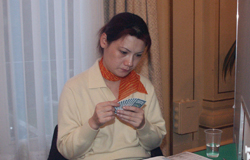| 36th World Team Championships, Monte Carlo, Monaco | Saturday Evening, 15 November 2003 |
Crouching tigers With 16 deals to go in the Venice Cup final, USA I led China by a score of 193.3-169. It was a useful lead, but not insurmountable. There were some nervous moments for the Americans, but they eventually prevailed. Here are few deals from the last round. USA I started off with an 11-IMP swing.
Janice Seamon-Molson and Tobi Sokolow had an excellent auction to the top spot in the closed room.
Sokolow knew her partner was not introducing a four-card suit at the four level, so she accurately pictured a hand with 6-5 shape. The chances were good, therefore, that Seamon-Molson had a singleton or void in diamonds. Indeed, the ¨A was the only trick for the defense. That was plus 920 to USA I. Curiously, the Chinese in the open room had a more difficult time without interference.
Perhaps the meaning of 4NT was not entirely clear to Liping Wang. In any case, Wenfei Wang considered her final call for some time before putting the green pass card on the table. China picked up 5 IMPs on the next deal when Sue Picus and Jill Levin got too high in a heart partial, going minus 50 against plus 140 in the closed room. China trailed 204.3-182 when the following deal came up.
Levin led a low spade, which Wenfei rode around to her 5. She cashed the ©A, went to dummy with the ¨A and played a low heart to the 8, queen and king. That was the only trick for the defense. Plus 980. The auction got out of hand in the closed room.
Sokolow’s 5§ asked for key cards in spades excluding the club suit, and 6© would normally be an inquiry about the ©K. Whether that is the meaning in the Americans’ bidding system, the result was a leap to a no-play grand slam and a loss of 14 IMPs. Halfway through the match, China had whittled the American’s lead to 13.3 IMPs. The next deal could have swung the match to the Chinese.
Wenfei’s 2¨ showed a weak two-bid in a major. Liping correctly deduced that her partner’s suit was spades, and she started with the ªJ. Wenfei ducked to Levin’s king. The contract was very shaky. Levin could not afford to lose an early trick. It would be down a lot if she did. At trick two, Levin put the §J on the table, covered by North with the queen. Levin took the §K and advanced the ©J, also covered, and she finished with 10 tricks for plus 180. It might seem to have been an error for North cover the §J at trick two, but Seamon-Molson, defending 3NT in the other room, said she probably would have done the same, reasoning that West was unlikely to have a six-card club suit and that the only chance was for her partner to have four to the 8-7.
China managed an 11-IMP swing on t he next-to-last board, but by then the margin was too great for them to overcome. The final score was 229.3-210. When the Chinese players entered the VuGraph auditorium after the match, they received an hearty round of applause from the spectators who had watched them fight valiantly on their way to a silver medal. |
||||||||||||||||||||||||||||||||||||||||||||||||||||||||||||||||||||||||||||||||||||||||||||||||||||||||||||||||||||||||||||||||||||||||||||||||||||||||||||||||||||||||
| Page 4 |

